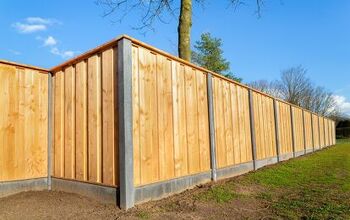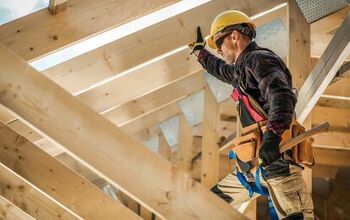What Size Screws For A Wood Fence? (Find Out Now!)

Along with improving security, wood fences can enhance the beauty and value of your property. Just like any other project, it’s important that you have all the necessary tools to get the job done. When you’re building a new wooden fence, the fasteners that you use are vital to both the style and long-term performance. This begs the question: what size wood fence screws should you use?
You should typically use fence screws that are 3 ½ to 4 inches long when attaching preassembled panels to fence posts. On the other hand, you’ll only need to use 1 ½ inch wood fence screws to attach individual pickets to backer rails. Overall, you should always use screws over nails when building a wood fence due to their durability.
Along with screw size, there are additional factors to consider when it comes to wood fence fasteners. This includes the material and length of the fastener as well as what goes into making the choice between screws or nails for fence building. In this guide, we’ll cover all these points to ensure your wood fence project goes off without a hitch.
Related Content: How Much Does It Cost To Fence 1/2 Acre? | Wood Fence Ideas | What Size Nails For Fence Pickets? | No I Need A Permit To Build A Fence?
Do You Need Fence Installation or Repair Services?
Get free, zero-commitment quotes from pro contractors near you.

Screws or Nails for Fence Building?
Before you decide the size for the best screws for wood fence building, you’ll first want to determine whether to you want to use nails or screws for fence pickets in the first place. There are advantages and disadvantages to each, the physical material the fastener is made out of, and the type.
This is a common question posed among homeowners and builders alike. The “screws vs. nails” question usually comes down to a matter of preference. Both are effective fasteners and have their own unique advantages and drawbacks. Nails can be much faster to install, which means less labor for you or the person you hire. However, fencing nails are more likely to loosen up over time.
Therefore, if you’re looking for optimum strength, screws are going to be the best choice.
Should you need to replace or repair a damaged part of the fence, screws are also much easier to remove and work around. Alternatively, you can make use of both by attaching the pickets to the backer rails with nails and the panels/backer rails to posts with screws.
What Size Screws For Wood Fence?
First and foremost, the size of your screws is absolutely crucial to the success of your wood fence project. As previously mentioned, the length need will depend on the nature of the install.
If you’re simply attaching backer rails or preassembled panels to fence posts, use screws that are 3-1/2 to 4 inches long. If, instead, you are attached separate pickets to backer rails, it is recommended to use 1-1/4 inch to 1-3/4-inch-long screws.
In addition to length, you also want to consider the diameter of the screw, or the gauge. Screw gauges come in 2 through 16.
For most applications, you’ll want to use a screw with a #8 gauge. However, if the wood material you are working with is exceptionally heavy or thick, opt for #12-#14. If you are performing much finer woodworking, screws with a #6 gauge is often the best choice.
What Size Nails For Wood Fence?
If you’ve decided to use nails on your wood fence instead of screws, the recommendation is relatively the same: the right choice is based on the way you are installing the fence.
If you intend to attach individual pickets to backer rails, opt for nails that are between 8d and 10d. On the other hand, if you are affixing pre-assembled panels or backer rails to fence posts, we suggest using 18d to 20d nails.
What Fasteners Are Best for Wood Fences?
The size of the fastener is just one piece of the puzzle when it comes to ensuring stability and achieving a particular look with your wood fence. You’ll also want to consider the right fastener material, which will mostly depend on what type of wood you are using to build your wooden fence.
Fastener Material
Whether you choose nails or screws, the material that the fastener is made out of will be dependent on the type of wood that you use to build your fence. Put simply, some wood species and fastener materials do not mesh well and this is a common mistake that DIYers make. If you choose the wrong material, you may end up with some adverse results that compromise the structural integrity and appearance of your fence.
- Cedar: For fences made of cedar, you’ll want to use stainless steel, polymer-coated, or double hot-dipped galvanized fasteners. Avoid using anything made of zinc-plated steel, as the zinc in the fasteners can negatively react with the acids in the cedar and result in corrosion streaks.
- Pressure-Treated Wood: For pressure-treated wood species, such as pine, it is essential that you select a compatible fastener. The preservatives that are used during the pressure-treatment process can react with various materials and cause the fasteners to rust. For best results, you’ll want to use a fastener that is stainless steel, copper, silicon bronze, polymer-coated, or hot-dipped galvanized. These fasteners can fluctuate in strength and cost, so select one that is most suitable for your particular project.
- Non-Pressure-Treated Wood: With any type of wood that is not pressure treated, zinc-plated steel or virtually any other type of fastener is appropriate. In fact, since the wood doesn’t go through any treatment process, you won’t have to worry too much about the fastener material reacting negatively to the wood.
To ensure that you are making the best fastener material choice for your fence, always consult the manufacturer’s recommendations first.
Recommended Wood Fence Fasteners
| Type of Wood | Do Use | Do NOT Use |
| Cedar or Redwood | Stainless Steel Double Hot-Dipped Galvanized | Zinc-Plated Dacrotized Interior Rated |
| Pressure Treated | Hot-Dipped Galvanized Stainless Steel Polymer- or Ceramic-Coated | Zinc-Plated Dacrotized Interior Rated |
| Untreated | Zinc-Plated Dacrotized Most Other Fasteners | Interior Rated |
What are the Best Screws for Wood Fence Building?
In addition to fastener material, the type of screw can play a role in the stability of your fence. Some of the best screws for fencing include:
- Lag Screws: Often used in tall wooden fences or heavy planking, lag screws have strong bonding capabilities due to their hexagonal heads. These screws come in silicon bronze, galvanized, uncoated, and stainless steel.
- Deck Screws: Sometimes referred to as ‘green screws,’ deck screws are the ideal choice for pressure-treated wood. They are coated with an epoxy to prevent pressure-treated wood from possible corrosion. Deck screws also come in a wide variety of types, lengths, and diameters. To install, use either a Phillips head or square drive type screwdriver.
- Silicon Bronze Screws: Silicon bronze screws consist of a metal alloy that is rust-resistant. These types of screws are the best choice for wood fences that are built near riverbanks, lakes, oceans, or anywhere with a lot of moisture.
- Galvanized Screws: For untreated wood species, galvanized screws are recommended. They are coated with zinc to keep the wood from discoloring, rusting, or staining.
Preparing to Use Wood Fence Screws
The amount of screws you use will depend on the size of your fence. As a general rule of thumb, use at least six screws per panel when attaching 1×6 fence boards to a 2×4 frame. Typically, they should penetrate at least half the thickness of the base material. For example, if you are screwing into a 2×4, the screw should be 3/4 inch in length to go in enough.
Although it isn’t required, pilot holes can keep the wood from cracking or splitting when you drive the screws in. When you drive screws into wood without pilot holes, you are basically pushing wood out of the way to make enough room for the screw. This evacuated wood places pressure on the wood area surrounding the screw, which can result in cracking, splitting, and will certainly weaken the wood over time.
Do You Need Fence Installation or Repair Services?
Get free, zero-commitment quotes from pro contractors near you.

Wrapping It Up
To summarize, you should use 3 ½-to-4-inch long fence screws when attaching preassembled panels to fence posts and 1 ½ inch wood fence screws to attach individual pickets to backer rails. Selecting the best fastener for your wood fence project comes down to these steps:
- Determine whether you want to use nails or screws.
- Choose a fastener material that is suited for the type of wood you are using.
- Select the type of screw or nail that you want to use.
- Find the appropriate fastener size (length and gauge) based on the nature of your install.
When it comes to fasteners, there are a number of options available to you. However, if you have a solid understanding of the wood you are using, the decision will be much easier.
Related Guides

Jessica considers herself a home improvement and design enthusiast. She grew up surrounded by constant home improvement projects and owes most of what she knows to helping her dad renovate her childhood home. Being a Los Angeles resident, Jessica spends a lot of her time looking for her next DIY project and sharing her love for home design.
More by Jessica Stone




















![Standard Dining Room Table Dimensions [for 4, 6, 8, 10 and 12 People]](https://cdn-fastly.upgradedhome.com/media/2023/07/31/9074335/standard-dining-room-table-dimensions-for-4-6-8-10-and-12-people.jpg?size=350x220)






